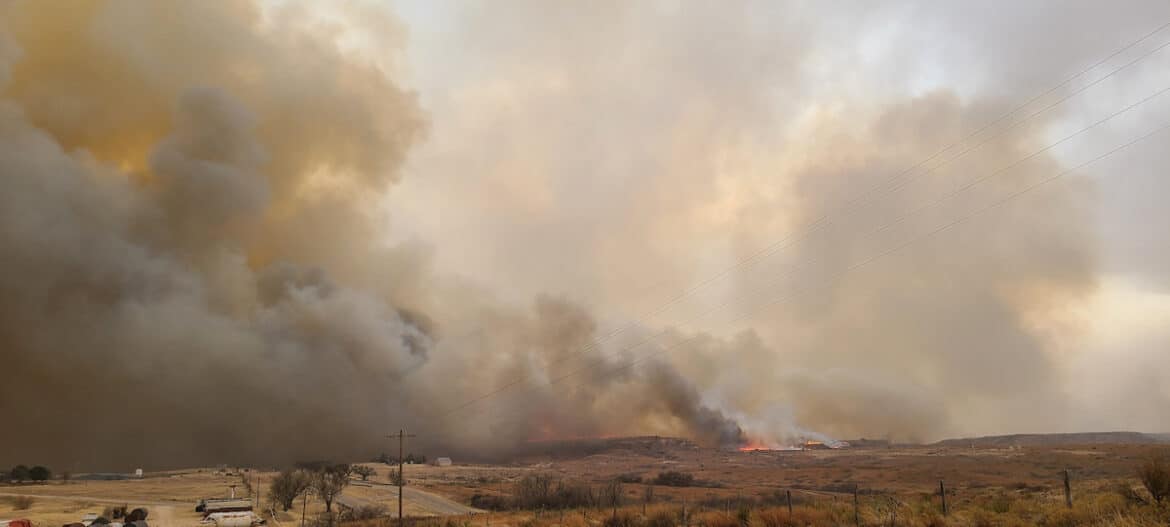Wildfires in Oklahoma and Texas have burned more than one million acres and devastated farmers and ranchers in the region. On Thursday morning, the Smokehouse Creek Fire merged with another fire and was in both states. By Friday night, the Smokehouse Creek Fire was the largest in Texas history at almost 1,700 square miles — and 15% contained, according to Texas A&M Forest Service.
Prior to this fire, AP noted that “The largest fire recorded in state history was the 2006 East Amarillo Complex fire, which burned about 1,400 square miles and resulted in 13 deaths.” Currently two deaths have been blamed on the current wildfires, although there still needs to be a more extensive search for victims.
On Friday, Texan Gov. Greg Abbott held a press conference and said already as many as 500 structures were destroyed in the Panhandle and the number could rise. “When you look at the damages that have occurred here, it’s just gone, completely gone, nothing left but ashes on the ground,” Abbott said, according to Associated Press.
Homes weren’t the only ones damaged or lost to the flames. Livestock owners are dealing with lost and injured cattle, as well as the loss of feed as valuable grass and hay supplies were burned. Texas Agriculture Commissioner Sid Miller estimated the cattle deaths would be in the thousands, with the number will rise. “There’ll be cattle that we’ll have to euthanize,” Miller said. “They’ll have burned hooves, burned udders.”
Texas A&M AgriLife Extension Service on Thursday said donations of hay, feed, fencing supplies, cow feed and milk replacer are needed to support livestock owners affected by the wildfires.
The extension service said it is “establishing Animal Supply Points in several locations in the region to accept the donations. The purpose of the Animal Supply Point is to meet area producers’ most critical needs such as providing feed for cattle while they assess their individual operation’s other needs.”
“These donations will go directly to those who need them as soon as possible,” said Monty Dozier, AgriLife Extension Disaster Assessment Recovery, DAR, program director, Bryan-College Station. “Texans are known for their generosity and deep values of Texas agriculture during times of need. This is certainly a situation where our neighbors and friends are needing assistance after these fires have threatened their livelihoods.”
See more on how to donate money, hay, feed, fencing materials, and more check out:
- Texas A&M AgriLife Extension Service
- Texas & Southwestern Cattle Raisers Association
- Texas Farm Bureau
- Oklahoma Cattlemen’s Foundation
Just prior to the start of the fires, Texas Farm Bureau had warned how short hay supplies already were in Texas. On Feb. 22, Farm Bureau’s Field Editor Shelby Shank wrote a blog noted that said AgriLife Extension Economist Dr. David Anderson had noted Dec. 1, 2023 hay stocks were the lowest on record behind 2022 and 2021.
While it still needs to be determined how the fires started in the Texas Panhandle, Quentin Shieldknight, who farms in the Texas Panhandle near Spearman, Texas pointed to the volatile weather conditions the area faced. “It’s pretty simple as to what happened. We had a drought two years ago and forced the cows out. Last year we had an abundance of rain and grass but few cows. That allowed a lot of pastures to grow and all it took was one spark of any kind to start it in 80-degree weather and 60-mph winds to spread it,” said Shieldknight.
###
DTN/TDA/Texas Farm Bureau/Agrilife Extension


